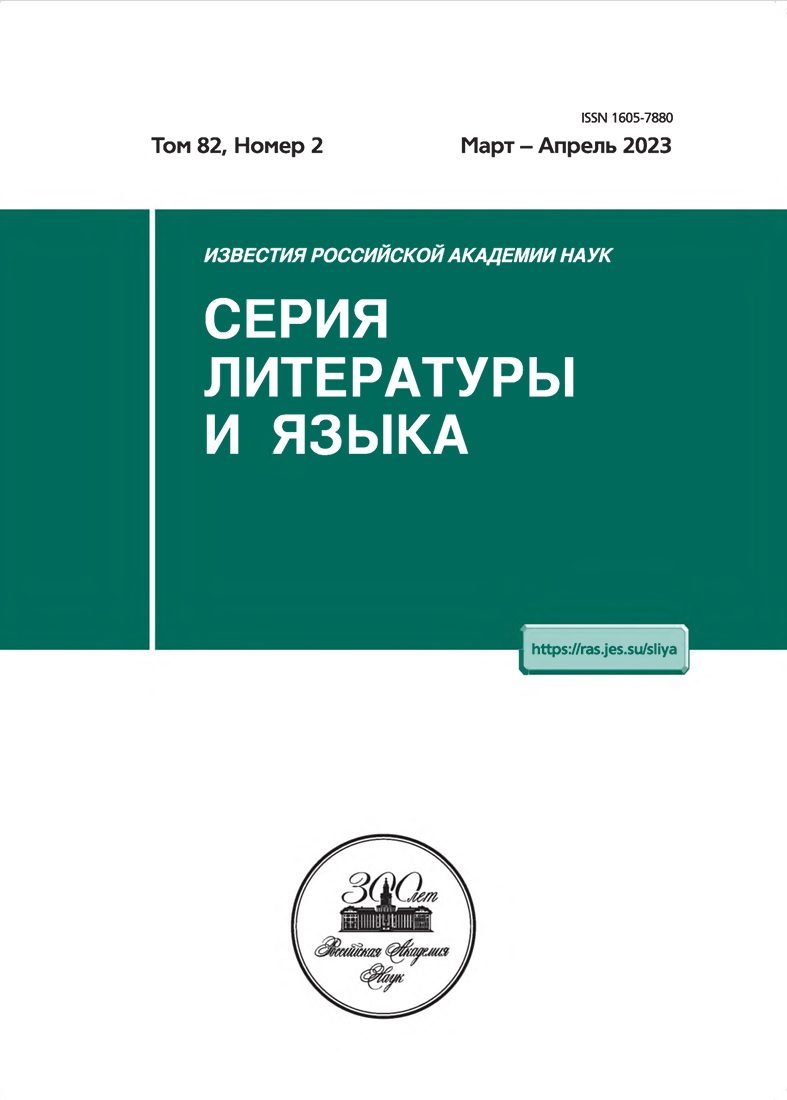A Typology of “Small” Evenutalities: Discontinuatives and Verbal Diminutives
- 作者: Makarchuk I.V.1
-
隶属关系:
- HSE University
- 期: 卷 82, 编号 2 (2023)
- 页面: 92-103
- 栏目: Articles
- URL: https://rjonco.com/1605-7880/article/view/656980
- DOI: https://doi.org/10.31857/S160578800025506-2
- ID: 656980
如何引用文章
详细
This article looks at two types of verbal derivations with a meaning of a lesser situation, which we have named discontinuatives and verbal diminutives. We show that these two types are of different diachronic origin: the former comes from verbal pluractionality, and the latter comes from nominal diminutives. We describe aspectual properties of the derivations and show how differences in distribution can be explained by the origin of the derivations.
参考
- Henri F., Winterstein G. Morpho-Semantics of Verbal Reduplication: the case of Mauritian. Presented at 17th International Conference on Head-Driven Phrase Structure Grammar (HPSG). Université Paris Diderot, Paris 7, France. 2010.
- Amiot D., Stosic D. When evaluative morphology, pluractionality and aspect get tangled up: a case study of French suffixed verbs // Gavriilidou Z., Revithiadou A. (eds.) Mélanges offerts à Anna Anastassiades-Syméonides à l’occasion de sa retraite. Kavala: Saita Publishers, 2014. P. 16–33.
- Audring J., Leufkens S., van Lier E. Small events. Verbal diminutives in the languages of the world // Linguistic Typology at the Crossroads. 2021. Vol. 1, № 1. P. 223–256.
- Makarchuk I.V. Typology of verbal attenuative. Master thesis. Moscow: HSE, 2020.
- Moravscik E.A. Reduplicative constructions // Greenberg J.H. (ed.) Universals of Human Language. Stanford: Stanford University Press, 1978. Vol. 3: Word Structure. P. 297–334.
- Christaller J.G. A grammar of the Asante and Fante language called Tshi (Chwee, Twi). Basel: Gregg Press Inc., 1875.
- Robins R.H. Nominal and verbal derivation in Sudanese // Lingua. 1959. № 8. P. 337–369.
- Kouwenberg S., LaCharité D. Less is more: Evidence from diminutive reduplication in Caribbean creole languages // Hurch B. (ed.) Studies on Reduplication. Berlin: Mouton de Gruyter, 2005. P. 533–545.
- Kiyomi S. A new approach to reduplication: a semantic study of noun and verb reduplication in the Malayo-Polynesian languages // Linguistics. 1995. Vol. 33, № 6. P. 1145–1167.
- Henri F., Winterstein G. Morpho-Semantics of verbal reduplication: The case of Mauritian. 2014.
- Булыгина Т.В. К построению типологии предикатов в русском языке // Семантические типы предикатов. М., 1982. C. 7–85.
- Падучева Е.В. Накопитель эффекта и русская аспектология // Вопросы языкознания. 2004. № 5. С. 46–57.
- Tatevosov S.G. Plural vs. Discontinuous Events: Degree Modification in Chuvash // Kelepir M., Öztürk B. (eds.) Proceedings of WAFL 2: Workshop on Altaic Formal Linguistics. Cambridge: MITWPL, 2006. P. 347–364.
- Тенишев Э.Р. (отв. ред.) Сравнительная-историческая грамматика тюркских языков. Морфология. М.: Наука, 1988.
- Левитская Л.С. Историческая морфология чувашского языка. М.: Наука, 1976.
- Севортян Э.В. Аффиксы глаголообразования в азербайджанском языке: Опыт сравнительного исследования. М., 1962.
- Михайлов С.К. Горномарийский фреквентатив в типологической перспективе. Курсовая работа. М., НИУ ВШЭ, 2018.
- Mikhailov S.K. Hill Mari Frequentative: Event-internal Pluractionality on the Verge of Evaluation. Presented at 4th workshop on Volga-Kama languages: programme. Higher School of Economics, Moscow, 2018.
- Рахилина Е.В., Резникова Т.И., Карпова О.С. Семантические переходы в атрибутивных конструкциях: метафора, метонимия, ребрендинг // Рахилина Е.В., Резникова Т.И. (ред.) Лингвистика конструкций. М.: Азбуковник, 2010. С. 396–453.
- Галкин И.С. Историческая грамматика марийского языка. Йошкар-Ола: Марийское книжное издательство, 1966. Т. 2.
- Collinder B. Comparative Grammar of the Uralic Languages. Uppsalla: Almqvist&Wiksell, 1960.
- Grandi N. Word-formation and lexical aspect: deverbal verbs in Italian // Müller P.O., Ohnheiser I., Olsen S., Rainer F. (eds.) Word-Formation. Berlin / Boston: De Gruyter, 2015. Vol. 2. P. 1467–1482.
- Tovena L.M. When Small Is Many in the Event Domain // Lexis. 2011. № 6.
- Tovena L.M. Evaluative Morphology and Aspect / Actionality // Grandi N., Körtvélyessy L. (eds.) Edinburgh Handbook of Evaluative Morphology. Edinburgh: Edinburgh University Press, 2015. P. 108–120.
- Grestenberger L., Kallulli D. The largesse of diminutives: suppressing the projection of roots // Baird M., Pesetsky J. (eds.) Proceedings of NELS 49. Amherst: GLSA, 2019. Vol. 2. P. 61–74.
- Audring J., Booij G., Jackendoff R. Menscheln, kibbelen, sparkle: Verbal diminutives between grammar and lexicon // Linguistics in the Netherlands. 2017. Vol. 34. №1. P. 1–15.
- Weidhaas T., Schmid H.-J. Diminutive verbs in German: semantic analysis and theoretical implications // Morphology. 2015. Vol. 25, № 2. P. 183–227.
- Katunar D. Diminutives in Action: A cognitive account of diminutive verbs and their suffixes in Croatian // Suvremena lingvistika. 2013. Vol. 39, № 75.
- Lakoff G. Women, Fire and Dangerous Things. Chicago: University of Chicago Press, 1987.
- Grestenberger L., Kallulli D. Сross-categorial syncretism: evidence from diminutives. Brussels, 2019.
- Brucale L., Mocciaro E. Suffissi valutativi in Plauto: una proposta cognitivista e morfo-pragmatica // Lingue antiche e moderne. 2020. Vol. 9. P. 57–86.
- Ronelle A. Bosnian, Croatian, Serbian, a Grammar with Sociolinguistic Commentary. Madison: The University of Wisconsin Press, 2006.
补充文件









